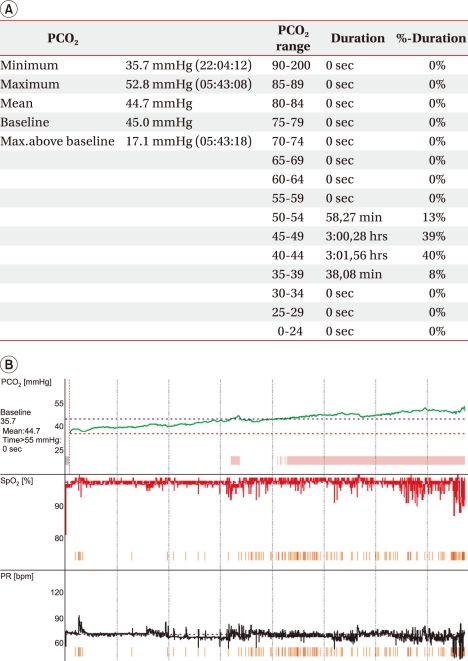1. Dorrington KL, Balanos GM, Talbot NP, Robbins PA. Extent to which pulmonary vascular responses to PCO
2 and PO
2 play a functional role within the healthy human lung. J Appl Physiol. 2010; 108:1084–1096. PMID:
20185627.
2. Bolliger D, Steiner LA, Kasper J, Aziz OA, Filipovic M, Seeberger MD. The accuracy of non-invasive carbon dioxide monitoring: a clinical evaluation of two transcutaneous systems. Anaesthesia. 2007; 62:394–399. PMID:
17381578.

3. Akai L, Ishizaki S, Matsuoka M, Homma I. Characteristics of respiratory pattern and anxiety in rhythmic gymnasts. Adv Exp Med Biol. 2010; 669:329–332. PMID:
20217376.

4. Masaoka Y, Homma I. Anxiety and respiratory patterns: their relationship during mental stress and physical load. Int J Psychophysiol. 1997; 27:153–159. PMID:
9342646.

5. Pfaltz MC, Grossman P, Michael T, Margraf J, Wilhelm FH. Physical activity and respiratory behavior in daily life of patients with panic disorder and healthy controls. Int J Psychophysiol. 2010; 78:42–49. PMID:
20472006.

6. Storre JH, Magnet FS, Dreher M, Windisch W. Transcutaneous monitoring as a replacement for arterial PCO
2 monitoring during nocturnal non-invasive ventilation. Respir Med. 2011; 105:143–150. PMID:
21030230.
7. Janssens JP, Howarth Frey C, Chevrolet JC, Abajo B, Rochat T. Transcutaneous PCO
2 to monitor noninvasive mechanical ventilation in adults: assessment of a new transcutaneous PCO
2 device. Chest. 1998; 113:768–773. PMID:
9515855.
8. Bach J, Alba A. Noninvasive options for ventilatory support of the traumatic high level quadriplegic patient. Chest. 1990; 98:613–619. PMID:
2203616.

9. Kang SW. Pulmonary rehabilitation in patients with neuromuscular disease. Yonsei Med J. 2006; 47:307–314. PMID:
16807978.

10. Choi WA, Kang SW, Shin JC, Lee DY, Kim DH, Kim SD. Noninvasive respiratory management for patients with cervical spinal cord injury. J Korean Acad Rehabil Med. 2010; 34:518–523.
11. Kang SW, Choi YC. Park CI, Moon JH, editors. Rehabilitation of Neuromuscular disease. Rehabilitation medicine. 2007. Seoul: Hanmi;p. 672.
12. Brogan TV, Hedges RG, McKinney S, Robertson HT, Hlastala MP, Swenson ER. Pulmonary NO synthase inhibition and inspired CO
2: effects on V'/Q' and pulmonary blood flow distribution. Eur Respir J. 2000; 16:288–295. PMID:
10968505.
13. Epstein SK. Late complications of tracheostomy. Respir Care. 2005; 50:542–549. PMID:
15807919.
14. Kang SW. Pulmonary rehabilitation in patients with neuromuscular disease. Yonsei Med J. 2006; 47:307–314. PMID:
16807978.

15. Larson CP Jr, Vender J, Seiver A. Multisite evaluation of a continuous intraarterial blood gas monitoring system. Anesthesiology. 1994; 81:543–552. PMID:
8092498.

16. Bussotti M, Magri D, Previtali E, Farina S, Torri A, Matturri M, Agostoni P. End-tidal pressure of CO
2 and exercise performance in healthy subjects. Eur J Appl Physiol. 2008; 103:727–732. PMID:
18521623.
17. Liu J, Simpson MD, Yan J, Allen R. Tracking time-varying cerebral autoregulation in response to changes in respiratory PaCO
2. Physiol Meas. 2010; 31:1291–1307. PMID:
20720290.
18. Vieillard-Baron A, Prin S, Augarde R, Desfonds P, Page B, Beauchet A, Jardin F. Increasing respiratory rate to improve CO
2 clearance during mechanical ventilation is not a panacea in acute respiratory failure. Crit Care Med. 2002; 30:1407–1412. PMID:
12130953.
19. Hazenberg A, Zijlstra JG, Kerstjens HA, Wijkstra PJ. Validation of a transcutaneous CO
2 monitor in adult patients with chronic respiratory failure. Respiration. 2011; 81:242–246. PMID:
21242669.

20. Hinkelbein J, Floss F, Denz C, Krieter H. Accuracy and precision of three different methods to determine PCO
2 (PaCO
2 vs. PetCO
2 vs. PtcCO
2) during interhospital ground transport of critically ill and ventilated adults. J Trauma. 2008; 65:10–18. PMID:
18580512.
21. Janssens JP, Perrin E, Bennani I, de Muralt B, Titelion V, Picaud C. Is continuous transcutaneous monitoring of PCO
2 (TcPCO
2) over 8 h reliable in adults? Respir Med. 2001; 95:331–335. PMID:
11392572.
22. Nilsson E, Lagercrantz H. Validity of transcutaneous PO
2 monitoring as compared with intra-arterial PO
2 monitoring in newborn infants. Lancet. 1982; 1:1241. PMID:
6122991.
23. Rosner V, Hannhart B, Chabot F, Polu JM. Validity of transcutaneous oxygen/carbon dioxide pressure measurement in the monitoring of mechanical ventilation in stable chronic respiratory failure. Eur Respir J. 1999; 13:1044–1047. PMID:
10414402.

24. Storre JH, Steurer B, Kabitz HJ, Dreher M, Windisch W. Transcutaneous PCO
2 monitoring during initiation of noninvasive ventilation. Chest. 2007; 132:1810–1816. PMID:
18079217.
25. Kocher S, Rohling R, Tschupp A. Performance of a digital PCO
2/SPO
2 ear sensor. J Clin Monit Comput. 2004; 18:75–79. PMID:
15362268.
26. Mahutte CK, Michiels TM, Hassell KT, Trueblood DM. Evaluation of a single transcutaneous PO
2-PCO
2 sensor in adult patients. Crit Care Med. 1984; 12:1063–1066. PMID:
6439472.
27. Eberhard P. The design, use, and results of transcutaneous carbon dioxide analysis: current and future directions. Anesth Analg. 2007; 105(6 Suppl):S48–S52. PMID:
18048898.






 PDF
PDF ePub
ePub Citation
Citation Print
Print


 XML Download
XML Download